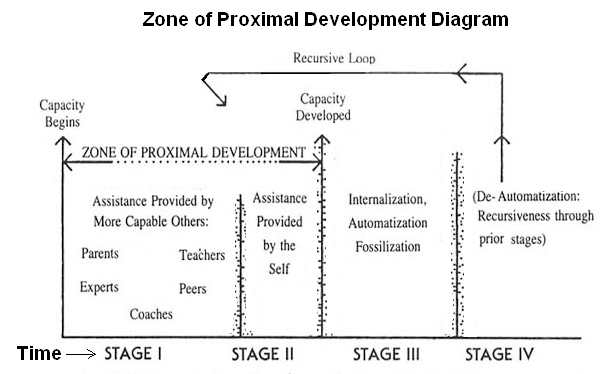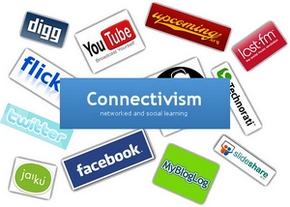Instructional Design Models, Theories & Methodology:
Behaviorism, Cognitivism, Constructivism & Connectivism
A Quick Comparison of all Theories
Questions |
Behaviorism |
Cognitivism |
Constructivism |
Connectivism |
How does learning occur? |
Black box - observable behavior main focus |
Structured, computational |
Social, meaning created by each learner (personal) |
Distributed within a network, social, technologically enhanced, recognizing and interpreting patterns |
What factors influence learning? |
Nature of reward, punishment, stimuli |
Existing schema, previous experiences |
Engagement, participation, social, cultural |
Diversity of network |
What is the role of memory? |
Memory is hardwiring of repeated experiences - where reward and punishment are most influential |
Encoding, storage, retrieval |
Prior knowledge remixed to current context |
Adaptive patterns, representative of current state, existing in networks |
How does transfer occur? |
Stimulus, response |
Duplicating knowledge constructs of "knower" |
Socialization |
Connecting to (adding nodes) |
What types of learning are best explained by this theory? |
Task-based learning |
Reasoning, clear objectives, problem solving |
Social, vague ("ill defined") |
Complex learning, rapid changing core, diverse knowledge sources |
Source: Ireland, T. (2007)
BEHAVIORISM
According to the learning theories propounded by the behaviorists learning is a mechanical process of associating the stimulus with response, which produces a new behavior. Such behavior is strengthened by the reinforcement. Main proponents of this theory were J.B.Watson and I.Pavlov. Behaviorists view the learner as a passive person who responds to the stimuli. According to them the learner starts as tabula rasa ( which means clean slate) and the behavior is shaped by the reinforcement. Positive as well as negative reinforcement increase the probability of the repetition of behavior. Whereas the punishment decreases the chances of repetition of the behavior. Learning is therefore defined as a change in the behavior of the learner.
The video given below explains behaviorism as a 'how' of education:
Behaviorism as a "how" of education, not a "what"
Use of this theory:
The techniques of reinforcement and punishment have been employed by the teachers in the classrooms to promote desirable behavior and discourage unwanted behavior of the learners.
Strengths:
1. It can be used to formulate behavioral contracts in the school as well as at home.
2. It is helpful in bringing about behavior modification (desired outcome) with the help of reinforcement, punishment and extinction.
3. Cueing responses to behavior allows the learner to react in a predictable way under certain conditions.
4. Success of outcomes is easily measurable.
5. Guarantees specific learning.
6. Ease of application.
Weaknesses:
1. Some critics say that it is an extrapolation of animal behavior to humans.
2. Behaviorism fails to explain the development of human languages.
3. Effect of environment in shaping the behavior of a human, is not taken into account by the behaviorists.
COGNITIVISM
 Cognitivism refers to the study of the mind and how it obtains, processes, and stores information (Stavredes, 2011). This theory was a response to behaviorism. It was argued that not all learning occurs through shaping and changing of behaviors. In this theory, learners are active participants in their learning, and the mind functions like a computer processor. Information comes in as input, the mind processes the information for the time being, and the information is stored away to be retrieved later (Learning Theories, 2011b). Learning is shaped by acquired learning strategies and prior knowledge and attitudes, called schemas. The cognitive view of learning is teacher-centered, and information must be presented in an organized manner in order to achieve the most efficient learning.
Cognitivism refers to the study of the mind and how it obtains, processes, and stores information (Stavredes, 2011). This theory was a response to behaviorism. It was argued that not all learning occurs through shaping and changing of behaviors. In this theory, learners are active participants in their learning, and the mind functions like a computer processor. Information comes in as input, the mind processes the information for the time being, and the information is stored away to be retrieved later (Learning Theories, 2011b). Learning is shaped by acquired learning strategies and prior knowledge and attitudes, called schemas. The cognitive view of learning is teacher-centered, and information must be presented in an organized manner in order to achieve the most efficient learning.
Use of this theory: Cognitivism is suited well for problem solving, where the concepts are complex and must be broken down into smaller parts. Ideas and concepts from these problems are linked to prior knowledge, which in turn helps the learner develop a stronger comprehension (Stavredes, 2011)
Strengths: Organized structure to learning: information comes in and is processed into short term memory before being stored away in long term memory. When problems are broken down into smaller parts, learners are not overwhelmed with incoming information and have time to process smaller bits.
Weaknesses: Because learning is very structured, it may become difficult to adapt to changes in what has already been processed and learned.
CONSTRUCTIVISM
Constructivism is the study of a learner's own construction of knowledge (Learning Theories, 2011c). This knowledge is constructed through one's own personal experiences and interactions with the outside world. The learner takes in new information and gives meaning to it using his or her own prior attitudes, beliefs, and experiences as references (Stavredes, 2011). Learners are active participants in the construction of knowledge while the instructor serves as a facilitator. Two types of constructivism emerged beginning in the late 1970s. Lev Vygotsky introduced social constructivism, in which social interaction with others helps the learner put meaning to information.
Vygotsky noted a Zone of Proximal Devleopment, in which learners can develop a certain level of meaning on their own but can grow even greater after interacting with classmates and instructors. In 1985, Jean Piaget introduced cognitive constructivism, in which knowledge is constructed by either assimilation or accommodation. In assimilation, incoming information is associated with a schema, and in accommodation, incoming information does not match a schema. Thus, the schema must be changed to accommodate this conflict (Stavredes, 2011).
Strengths: Constructivist activities are generally relevant to the learner and real-world based. Learners construct knowledge and meaning as they can relate the information to their own experiences, beliefs, and attitudes.
Weaknesses: Individual experiences and attitudes can vary. A specific, desired outcome may not always be achieved when different people approach the problem or task.
Use of this theory: Constructivism is best utilized when learners take control of the learning situation, such as in Problem-Based Learning. As learners engage themselves in an activity like this, they develop an understanding of the importance of the problem, comprehend the relevance of the topic, and construct knowledge through their experiences. It is more important to focus on the whole rather than the individual parts in constructivist learning (Stavredes, 2011). Constructivism is sometimes misconstrued as a theory that compels students to reinvent the wheel, but instead, it implores students to attempt to learn how it functions and apply this to real-world learning. (Educational Broadcasting, 2004)
Visual Overview of Behaviorism, Cognitivism, and Constructivism
Vygotsky and Constructivism
Any investigation of Constructivism, especially Social Constructivism, wouldn't be complete without a review of Lev Vygotsky’s (1896-1934) contributions. His “Zone of Proximal Development” (ZPD) forms an integral part of pedagogical theory: “...this zone is defined as the distance between the level of actual development and the more advanced level of potential development that comes into existence in interaction between more or less capable participants” (Cole & Wertsch, n.d., “Social Origins,” para. 4).
The ZPD epitomizes constructivist learning theory in action, how learning advances as it is built upon previous learning, and advances in stages through facilitation by a mentor more knowledgeable than the student.

Graphic source: http://www.buzzle.com/articles/zone-of-proximal-development.html
Vygotsky's Developmental Theory: An Introduction (Davidson Films)
As noted in the section on Constructivism above, “The learner takes in new information and gives meaning to it using his or her own prior attitudes, beliefs, and experiences as references (Stavredes, 2011).” The roots of this learning strategy lie in cultural-historical psychology, as expounded through the writings of Dewey, Durkheim, Vygotsky, and others. Here, “Higher mental functions are, by definition, culturally mediated; they involve not a ‘direct’ action on the world, but an indirect action, one that takes a bit of material matter used previously and incorporates it as an aspect of action” (Cole & Wertsch, n.d., “The Primacy of Cultural Mediation,” para. 5).
CONNECTIVISM
 Connectivism is a learning theory, in which knowledge exists outside of the learner, and the learner makes connections between information to build knowledge. The connections that learners make help them create their own learning network. Through this connected web, learners will be able to stay up-to-date with content as it changes. It is important for the learner to be able to identify credible resources. Siemens outlines the major ideas of connectivism as:
Connectivism is a learning theory, in which knowledge exists outside of the learner, and the learner makes connections between information to build knowledge. The connections that learners make help them create their own learning network. Through this connected web, learners will be able to stay up-to-date with content as it changes. It is important for the learner to be able to identify credible resources. Siemens outlines the major ideas of connectivism as:
- "Learning and knowledge rests in diversity of opinions"
- "Learning is the process of connecting specialized nodes or information sources"
- "Learning may reside in non-human appliances"
- "Capacity to know more is more critical than what is currently known"
- "Nurturing and maintaining connections is needed to facilitate learning"
- The ability to identify connections between concepts is important
- Maintaining current and accurate knowledge is the purpose in connectivist activities
- Decision-making is a learning process as information can change and what is viewed as correct one day may be incorrect the next (Siemens, 2004)
Use of this theory: This theory can be used whenever research needs to be conducted. In this digital age, learners can set up RSS feeds, follow organizations on Twitter, link to certain sites, search videos, and much more. With all of these resources available, learners can build a learning network that is constantly growing and can receive the most up-to-date information on any topic.
Strengths: Since learning is networked and connected to a variety of sources, information can be obtained easily and instantly. RSS Feeds and other Web 2.0 tools allow for the learner to retrieve the most recent updates to any topic.
Weaknesses: Because so many sources exist, it can become difficult to determine if a source is legitimate or not.
A summary of connectivism-
References:
Baker, T. (2011, January). "Connectivism." Image. Retrieved August 25, 2011 from http://profesorbaker.wordpress.com/2011/01/08/open-social-learning-connectivism-as-practiced-by-a-teacher-of-english-as-a-foreign-language
Behaviorism as a "how" of education, not a "what" [Video] Retrieved August 23,2011 from http://www.youtube.com/watch?v=SBfs7xuLRh0
Buzzle.com: Intelligent life on the web. The zone of proximal development. Retrieved August 24, 2011. http://www.buzzle.com/articles/zone-of-proximal-development.html
Cole, M., & Wertsch, J.V. (n.d.). Beyond the individual-social antimony in discussions of Piaget and Vygotsky. The Vygotsky Project. Retrieved August 24, 2011. __http://webpages.charter.net/schmolze1/vygotsky/_
Constructivism as a Paradigm for Teaching and Learning. (2004) Retrieved August 27th, 2011 from http://www.thirteen.org/edonline/concept2class/constructivism/index.html
Grace, E. (2009, July). "Computer Brain." Image. Retrieved August 25, 2011 from http://emilygracewriting.wordpress.com/2009/07/08/computer-brain
Ireland, T. (2007). Situating connectivism. Retrieved November 7, 2008, from http://design.test.olt.ubc.ca/Situating_Connectivism
Learning theories overview. (2010, November 6). Retrieved August 25, 2011 from YouTube Web site: http://www.youtube.com/watch?v=WcrD9ufag5s
Learning Theories Knowledgebase (2011a, August). Behaviorism at Learning-Theories.com. Retrieved August 24th, 2011 from http://www.learning-theories.com/behaviorism.html
Learning Theories Knowledgebase (2011b, August). Cognitivism at Learning-Theories.com. Retrieved August 24th, 2011 from http://www.learning-theories.com/cognitivism.html
Learning Theories Knowledgebase (2011c, August). Constructivism at Learning-Theories.com. Retrieved August 24th, 2011 from http://www.learning-theories.com/constructivism.html
Naik,P. (1998). Behaviorism as a Theory of Personality: A Critical Look. Retrieved August 25,2011 from http://www.personalityresearch.org/papers/naik.html
Standridge,M. (2008,February). Behaviorism.Retrieved August 25, 2011 from http://projects.coe.uga.edu/epltt/index.php?title=Behaviorism
Siemens, G. (2004, December). Connectivism: A learning theory for the digital age. Retrieved August 25, 2011 from http://citeseerx.ist.psu.edu/viewdoc/
download?doi=10.1.1.87.3793&rep=rep1&type=pdf
Strengths of Behaviorism. Retrieved August 25,2011 from http://pangea.tec.selu.edu/~jdugas/Strengths.htm
Stavredes, T. (2011). Effective online teaching: Foundations and strategies for student success. Retrieved August 8, 2011 from University of Illinois, College of Education Online Web site: http://learn.education.illinois.edu/file.php
/1647/LearningTheory-Jossey-Bass.pdf
Teacher Question of the Week: http://www.west.net/~ger/vygotsky.html
wdrexler [poster] (2008, November) Networked Student[video]. From http://youtu.be/XwM4ieFOotA
Vygotsky’s zone of proximal development - ETC 510. (2007-2009). Wiki site.http://sites.wiki.ubc.ca/etec510/Vygotsky's_Zone_of_Proximal_Development
